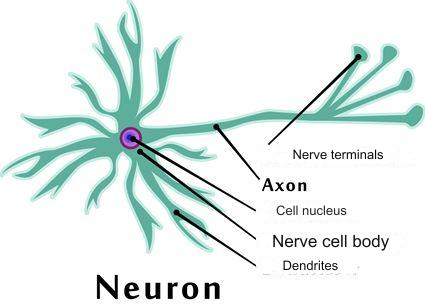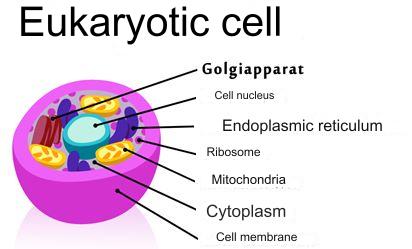DNA is made up of two long chains that resemble a ladder in appearance. The steps are made up of bases that match each other in pairs. Each DNA molecule contains four bases: A, G, C, and T, which is short for adenine, guanine, cytosine, and thymine. A complements with the base T, while C and G form pairs.
All cells contain 46 chromosomes, 23 from your mother and 23 from your father. However, germ cells contain only 23 chromosomes, but when an egg cell fuses with a sperm cell, it turns into a cell with 46 chromosomes.
The body’s organs are made up of tissues, which are made up of cells. They each have their own function, e.g. muscle cells must ensure that the muscles contract and perform a movement, while nerve cells conduct impulses to and from the brain. But in order for cells to perform their specific tasks, they need nourishment. If you want to know more, you can watch BioStriben’s videos on “Genetics”.
From food to energy
The human body can be compared to a complicated machine that requires fuel in order to function. Over time, it becomes worn down and needs to be repaired. At the same time as the spare parts are replaced, the body also grows and it is therefore necessary to eat proteins, carbohydrates and fats, as well as vitamins and minerals, which together are called nutrients. The nutrients we get through the food we eat. In addition to acting as spare parts and building material for the cells, food also provides energy to the body.
The body uses the energy to control all the processes that take place. For example, keeping warm, digesting food or making sure the heart beats. In short: All body functions depend on the nutrients.
Energy – the yield of food
Energy is a word that is used in many contexts. You probably know the feeling of being depleted of energy or having a lot of energy to play a football match. The body needs energy to function, just as a radiator also requires energy to heat a room, or a car requires energy when it has to drive from A to B. In the following section you can read what the body needs the energy for.
In the physical sense, energy is the ability to perform work. The unit of work and energy is the joule, abbreviated J. In conjunction with the body, the device kilojoule, abbreviated kJ, is more applicable. In the old days, energy associated with food was indicated in calories, cal, or kilocalories, kcal. The definitions are:
A joule is the work that a force of 1 newton performs when it moves an object 1 meter in the direction of the force.
A calorie is the amount of heat needed to heat 1 g of water from 14.5°C to 15.5°C.
ATP
Metabolism is the term for the body’s energy metabolism, i.e. its formation and consumption of energy. For the body to function, it needs energy. This energy is supplied via the substance ATP. The energy comes from the food and depending on the content of the meal and the state of the body, there are different ways to form energy. In order for the body to be in balance, an equilibrium between consumption and the formation of energy is required.
The body’s energy expenditure
The body uses energy to maintain physiological functions, such as converting the food you consume or being able to play a football game. The four main components of the body’s energy expenditure include:
Resting energy consumption
Restful energy consumption includes the energy needed for the body’s basic functions such as breathing, keeping the heart going, and regulating body temperature when the body is completely relaxed. Although the brain only makes up 2-3% of the body’s mass, it uses just over 20% of the energy supplied to the body through food.
Energy for physical activity
Physical activity refers to all movements that occur due to muscle contractions. This means that energy consumption increases in relation to energy consumption in a resting state.
When the body is used for everyday activities such as a football match or other physical work, it needs energy. Compared to energy expenditure in a resting state, physical activity can increase by a factor of 5-10, however, it depends on whether you run a marathon, play a football match or go for a walk. The muscle groups play a crucial role and the higher the intensity and the larger the muscle groups that are put to work, the more energy is consumed.
Energy for temperature control
When body temperature rises or falls, there is an increase in energy expenditure, however, it is a relatively insignificant contribution because our clothing helps to insulate the body.
Energy to digest and absorb the diet
After eating a meal, the food must be broken down and then absorbed into the body. This process requires energy, and about 10% of the total energy consumption per day comes from it. When the meal begins, there is an increase in energy expenditure that lasts 3-12 hours, depending on whether the meal contains many or few joules and the digestibility of it.
Burning the nutrients
When food is absorbed into the body, energy is generated. This is done by breaking down the various nutrients. The amount of energy supplied depends on the content of the meal. Carbohydrate and protein each provide 17 kJ per gram, while 1 gram of fat provides 38 kJ. If the body needs energy, it will always start by burning sugar, which is also called glucose. The breakdown of glucose is called glycolysis and is described in a later section. If the body’s glucose content is not sufficient in relation to the amount of energy needed, fat burning will start. The third nutrient, the proteins, is also burned by the body, but this only happens if the glucose and fat stores are exhausted. When this happens, the muscles break down and it is therefore the least useful way to generate energy.
Question:
One Snickers contains 1176 kJ. You burn 100 kJ when you jump high and fast for 2 minutes. How long do you have to jump to burn a Snickers?



